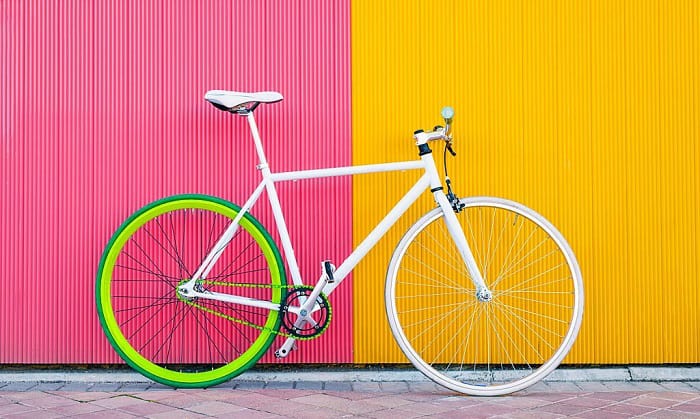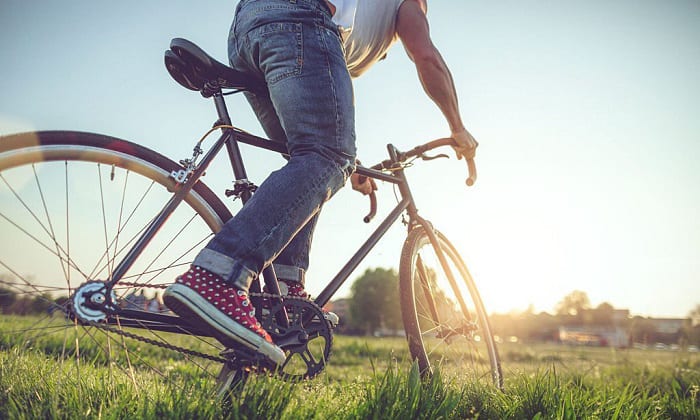A fixed-gear bicycle, commonly tagged as a “fixie”, is a road bike that runs on drop bars and a single fixed gear. To explain its mechanism in layman’s terms, if you pedal forward, the bike moves forward. The same applies if you pedal it backward, the bike will also move in reverse.
Unlike freewheel bikes, fixies need to be continuously pedaled to stay in motion. Generally, continuous pedaling means more exercise, as you are unable to freewheel or coast your way through.
What is a fixed gear bike, you might ask? Read on and see for yourself.
Table of Contents
Fixed Gear Bike Parts
Fixies prove that fewer parts do not mean less efficiency. These fixed-gear road bikes are low-maintenance, lighter, and potentially faster than the conventional ones.
- Ensure that your chain line must be straight and that there is enough tension in it.
- Frame, fork, and stem. One with horizontal dropouts is preferred by most cyclists. Ensure that they are compatible with each other.
- Handlebars
- Seatpost and clamp
- Front and rear wheels. Ensure that the rear wheel has a hub to accommodate a fixed gear cog and lock ring.
- Crankset and bottom bracket
- Toe clips may be added if you wish your feet attached to the pedals.
- Front brakes. Traditional fixies do not have brakes, but these are rectified because of recent reports of traffic injuries.
If you are intrigued enough to own one, the question “Are Fixie bikes cheap?” will surely come to mind. There are several fixed-gear bike brands ranging from a mere $100 to thousands of bucks, depending on your budget. Of course, the more you indulge in the hobby, upgrades and customizations are only inevitable, so you need to brace yourself for that as well.
How to Ride a Fixie
Switching to fixies can be quite tricky, especially in terms of control. Unlike conventional bikes with derailleurs and freewheel mechanisms where you can rest your legs from pedaling, fixies require constant work. I personally struggled at first but realized it gives me better workout and mileage outputs in the long run.
Step 1: Safety first
You might have been enticed by tricksters to switch to fixies, but always remember—being safe is more important than looking cool. Avoid injuries by wearing a helmet and other productive gear, and make sure to honor traffic laws in your area. As certain adjustments must be made by fixed beginners, practicing in safe areas before going into urban spaces or the freeway is highly advisable.
Step 2: Think Ahead
Keep your eyes on the road and pay attention to your surroundings—this is a standard rule for any operating vehicle. With fixies, it is advised to think a move or two in advance since some movements like cutting corners, and sudden braking proves to be challenging, especially for beginners. Needless to say, you always have to be prepared for any circumstances and must have fast reflexes to make adjustments on the go.
Step 3: Learn speed control
Riding fixies push you to your limits. Constant pedaling causes you to go faster and faster—it just feels liberating, and soon enough, you are hooked. Stay alert, however, because basic movements like cutting turns and maneuvering can be a bit trickier with these single-gear bikes. Hill climbs and descents are different from bikes with freewheels, and accidents can happen if you are cruising at a fast pace.
Step 4: Do not skip checks
Just because your fixie is low maintenance does not mean you do not need to check its gear cogs and cables regularly. I highly recommend giving it a once-over before and after the ride. Check if the nuts are properly tight, if the tension is still firm, and if there is no corrosive buildup in the frame. Trust me, this simple step can go a long way, and can save you from unnecessary repairs or injury expenses!
Conclusion
Fixed gear bikes may get a bad rep as a good population of its riders is in it for the stunts and thrills. However, there is an undeniable charm in it. Fixies are generally low maintenance, and their straightforward design allows the gears to work smoother, allowing them to keep up with a fast-paced, busy lifestyle. Having fewer parts means you get to travel faster and lighter. Additionally, if you are a hobbyist, they are highly customizable and can cater accordingly to your needs.
If you enjoyed this article about – what is a fixed gear bike? Let us know what you think in the comments section below.

“I ride my bike to work for years, but is that enough? Our carelessness towards our surroundings has taken a toll on the environment. And now, everyone is responsible for changes; even the most minor contribution is counted. With this hope and spirit, I started with my partner to establish Biketoworkday to help more individuals commute to their work sites on their bikes.”


